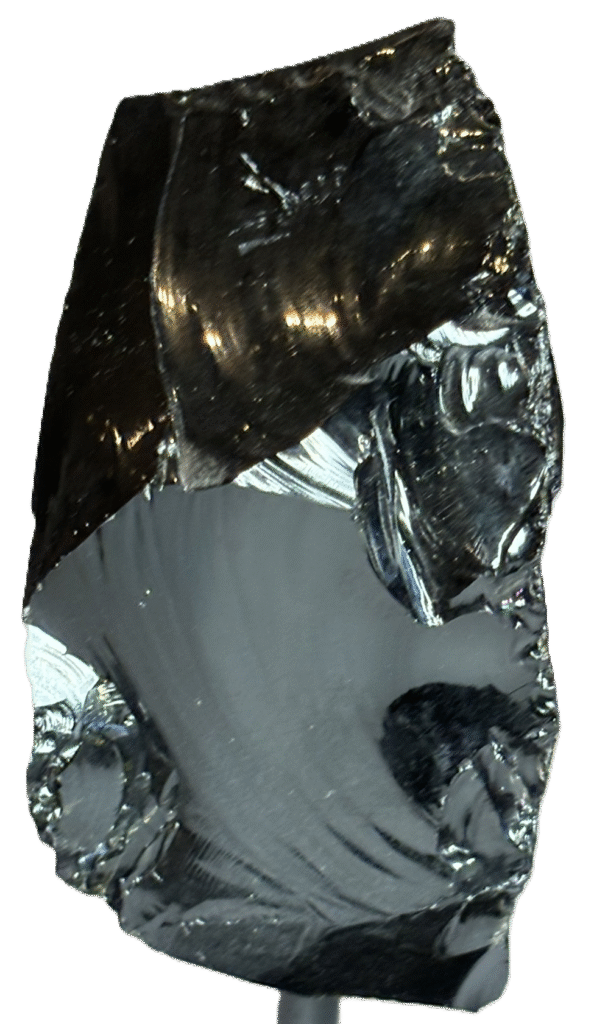
Obsidian derives its name from the Latin obsidianus, referring to its dark, lustrous appearance reminiscent of protective, ancient deities. It is also known as “volcanic glass” and, in various cultural contexts, by poetic names that evoke its inherent mystery and natural beauty.
Composition, Physical Characteristics, and Varieties
Composed predominantly of silica, Obsidian forms when lava cools rapidly without sufficient time for crystal growth. This rapid cooling process produces a distinctive glassy luster and conchoidal fracture pattern. Varieties of Obsidian include jet-black, mahogany, and rare forms featuring snowflake or rainbow patterns, each reflecting subtle differences in chemical composition and cooling history.
Geographical Locations Where It Is Found
Obsidian appears in regions of recent volcanic activity. Significant deposits have been discovered in the western United States, Mexico, Iceland, and across the Mediterranean.
Archaeological and Significant Finds: Historical and Current Usage
Historically, Obsidian played a pivotal role in early tool-making. Prehistoric communities exploited its razor-sharp edges to create cutting tools, weapons, and ceremonial artefacts. Notable archaeological finds in Mesoamerica and the American Southwest indicate that Obsidian was central to trade networks and cultural rituals. Today, its aesthetic allure continues to make it a favoured material in modern jewellery and sculpture.
Folklore, Legends, and Tales
The cultural significance of Obsidian extends into the realm of folklore, with various traditions imbuing the stone with mystical powers:
- Native American Beliefs: Many Native American tribes regarded Obsidian as a gift from the gods. In Mono Lake, California, sacred Obsidian cliffs supplied high-quality material for tools and weapons, forming a cornerstone of trade across the western United States.
- Apache Traditions: The Apache people believed Obsidian could reveal the future. They used Obsidian mirrors to scry, seeking guidance on forthcoming events and communicating with the spirit world.
- Aztec and Mayan Traditions: Both the Aztecs and Mayans revered Obsidian as a sacred stone. They fashioned mirrors, knives, and arrowheads from it, and Aztec priests used Obsidian mirrors to foretell the future. The Aztec god Tezcatlipoca, known as the Smoking Mirror, embodied these mystical properties, serving as a deity of the night, divination, and magic.
- Scottish Folklore: In Scotland, Obsidian is known as “the stone of scrying.” Legends recount that the seeress Thomas the Rhymer used an Obsidian mirror to predict significant events such as the Battle of Bannockburn and the death of King Robert the Bruce.
- African Traditions: In African folklore, Obsidian earns the title “the stone of truth.” It is frequently employed in divination practices, believed to reveal personal truths and protect against negative energies. Amulets and talismans fashioned from Obsidian are thought to promote spiritual growth.
Mystical Healing Properties, Astrology, and the Zodiac
In the realm of metaphysics, Obsidian is celebrated for its grounding and protective qualities. Practitioners assert that it dispels negative energy, fostering mental clarity and emotional resilience. Its mirror-like surface is said to reflect not only one’s inner self but also the cosmic energies that govern the zodiac. Obsidian is particularly favoured by those born under signs associated with transformation and introspection, aligning its energies with celestial phenomena.
The Chakra System
Obsidian is primarily linked to the base chakra. Its grounding influence stabilises the physical body, fostering a deep connection with the earth. Holistic practitioners use Obsidian to unblock energy pathways and ensure the proper alignment of chakras, thereby enhancing overall stability and spiritual balance.
Use as a Birthstone and for a Wedding Anniversary
In modern metaphysical practices, Obsidian is sometimes chosen as an alternative birthstone, especially for individuals who value protective and grounding energies. Its enduring allure also renders it a popular choice for commemorating wedding anniversaries. As a symbol of resilience and deep, unyielding beauty, Obsidian encapsulates both historical significance and contemporary mystique, making it a cherished gemstone for marking significant life milestones.

Obsidian
Obsidian offers sharp protection and deep insight. Born of volcanic fire, it clears negativity, reveals truth, and shields with intense grounding energy.
